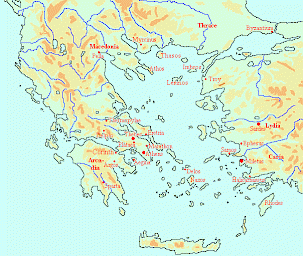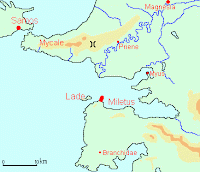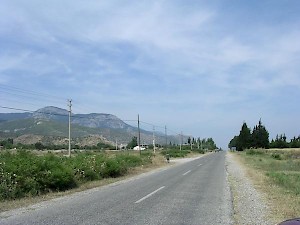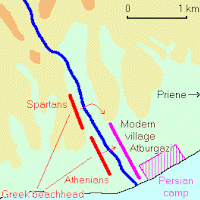Herodotus, bk 9, logos 27
Herodotus of Halicarnassus (c.480-c.429 BCE): Greek researcher, often called the world's first historian. In The Histories, he describes the expansion of the Achaemenid Empire under its kings Cyrus the Great, Cambyses, and Darius I the Great, culminating in Xerxes' expedition to Greece (480 BCE), which met with disaster in the naval engagement at Salamis and the battles at Plataea and Mycale. Herodotus' book also contains ethnographic descriptions of the peoples that the Persians have conquered, fairy tales, gossip, and legends.
The Liberation of Ionia (9.90-113)

While the events described in the preceding logos took place in Boeotia, the small Greek navy under command of the Spartan king Leotychides (above) was still at Delos. One day, three envoys from Samos arrive, asking for assistance by the liberation of the cities of the Ionian Greeks in Asia. They promise that the Ionians will revolt as soon as they see the navy of the allies. The omens are favorable and Leotychides agrees to move to Samos, and when they arrive, the Persian garrison sails away to he mainland, to the Mycale peninsula, where they join forces with the army that Xerxes had led back to Asia (above).

Even though Samos is now liberated, the escape of the Persians is a disappointment to the Greeks. They wonder what to do: return to Delos or move to the Hellespont? They decide to pursue the enemy, sail along the south coast of Mycale and disembark some kilometers east of the Persian camp. Meanwhile, the Persians send away their Ionian allies: e.g., the soldiers from Miletus are ordered to guard the passes in the mountains and the men from Samos are disarmed. (Herodotus explains that the Persian commanders distrusted these allies.)

Having landed on the Asian shores, the Greeks start to march against their enemies. Unusually, the Spartans occupy the left wing; the other wing is occupied by the Athenians, who enjoy an easy walk on the beach. During their advance, they find a herald's staff - a strange object to find on the seashore, and they think that it is a divine sign, signifying that the other Greeks had been victorious at Plataea. The Athenians are the first to reach the Persian camp, and they incite each other to attack before the Spartans reach the site. Soon, they are master of the camp; the Persians try to save their lives by fleeing into the mountains, but they discover that the Milesians who guard the passes have become their enemies. Only a few Persians survive and reach Sardes.

When the battle is over and the Spartans have arrived, the camp is looted and the Persian navy destroyed. Then, the Greeks return to Samos, where they discuss their next moves. The Spartans propose the evacuate the cities of the Ionian Greeks and bring the population to the Greek mainland; the Athenians object and accept the Ionian Greeks in a league against Persia.
Comment
The battle of Mycale was fought at more or less the same time as the battle of Plataea, probably in August 479. From a military point of view, its significance is that the Persian navy - already badly damaged at Salamis - was eliminated. The real significance was political: the Greek cities in Asia were liberated and were accepted in a league with Athens. This league was directed against Persia, but soon changed into an Athenian empire.